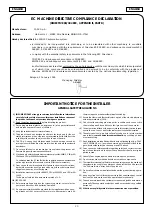
EN
I
•
Before using your automation system for the first time,
ask the installer to
explain the origin of any residual risks; take a few minutes and read the
users
instructions manual given you by the installer
. Retain the manual for future
use and deliver it to any subsequent owner of the automation system.
•
Your automation system is a machine that will faithfully execute your
commands;
unreasonable or improper use may generate dangers: do not oper-
ate the system if there are people, animals or objects within its range of operation.
•
Children:
automation systems are designed to guarantee high levels of safety
and security. They are equipped with detection devices that prevent movement if
people or objects are in the way, guaranteeing safe and reliable activation. How-
ever, children should not be allowed to play in the vicinity of automated systems;
to prevent any accidental activations, keep all remote controls away from children:
they are not toys!
•
Malfunctions:
If you notice that your automation is not functioning properly, dis-
connect the power supply to the system and operate the manual release device.
Do not attempt to make any repairs; call the installation technician and, in the
meantime, operate the system like a non-automatic gate after releasing the gear-
motor as described below.
•
Maintenance:
Like any machine, your automation needs regular periodic main-
tenance to ensure its long life and total safety. Arrange a periodic maintenance
schedule with your installation technician. Nice recommends that maintenance
checks be carried out every six months for normal domestic use, but this interval
may vary depending on the intensity of use. Only qualified personnel are author-
ized to carry out checks, maintenance operations and repairs.
• Do not modify the system or its programming and adjustment parameters in any
way, even if you feel capable of doing it: your installation technician is responsible
for the system.
• The final test, the periodic maintenance operations and any repairs must be docu-
mented by the person who has performed them; these documents must remain
under the custody of the owner of the system.
The only recommended maintenance
operations that the user can perform
periodically concern the cleaning of the photocell glasses and the removal of
leaves and debris that may impede the automation. To prevent anyone from acti-
vating the gate
release the automation system
(as described below). Use a
slightly damp cloth to clean.
•
Disposal:
At the end of its useful life, the automation must be dismantled by quali-
fied personnel, and the materials must be recycled or disposed of in compliance
with the legislation locally in force.
•
In the event of malfunctions or power failures.
While you are waiting for the
technician to come (or for the power to be restored if your system is not equipped
with buffer batteries), you can operate the system like any non-automatic gate. In
order to do this you need to manually release the gearmotor (this operation is the
only one that the user of the automation is authorized to perform): This operation
has been carefully designed by Nice to make it extremely easy, without any need
for tools or physical exertion.
Control with safety devices out of order:
If the safety devices are malfunctioning,
it is still possible to control the gate.
• Operate the gate control device (remote control or key-operated selector switch
etc.). If the safety devices enable the operation, the gate will open and close nor
-
mally, otherwise the flashing light flashes a few times but the manoeuvre does not
start (the number of flashes depends on the reason why the manoeuvre is not
enabled).
• In this case,
actuate
the control again within 3 seconds and
keep it actuated
.
• After approximately 2 s the gate will start moving in the “man present” mode, i.e.
so long as the control is maintained the gate will keep moving; as soon as the
control is released the gate will stop.
If the safety devices are out of order the automation must be repaired as
soon as possible.
1
– Slide the lock cover disc.
2
– Insert and turn the key clockwise.
3
– Pull the release handle.
4
– Move the leaf manually.
Replace the Remote Control Battery:
if your radio control after a period of time,
seems not to work as well, or not to work at all, it may simply be that the battery is
flat (depending on the type of use, it may last from several months up to one year
and more). In this case you will see that the light confirming the transmission is weak,
or does not come on, or comes on only briefly. Before calling the installation techni-
cian try exchanging the battery with one from another operating transmitter: if the
problem is caused by a low battery, just replace it with another of the same type.
Warning:
The batteries contain polluting substances: do not dispose of them
together with other waste but use the methods established by local regulations.
Manual movement and release:
before carrying out this operation please note
that release can only occur when the leaf is stopped.
To lock:
carry out the same procedures backwards.
Instructions and Warnings for users of Road400 gearmotor
Summary of Contents for ROAD 400
Page 4: ...III NL RU PL DE ES FR IT EN 16 17 18 19 20 21 22 23 24...
Page 5: ...IV EN IT FR ES DE PL NL RU F2 F1 25 26 27 28...
Page 100: ...RU 11 7 8 PS124 Road400 PS124 1 2 28 22 1 10 L2 L3 4 3 L3 L2 4 3...
Page 109: ...RU VIII Nice Nice 2 1 2 3 4 Road400...
Page 112: ...IS0350A02MM_03 07 2015 www niceforyou com Nice SpA Oderzo TV Italia info niceforyou com...











































